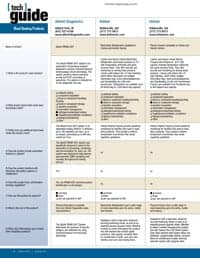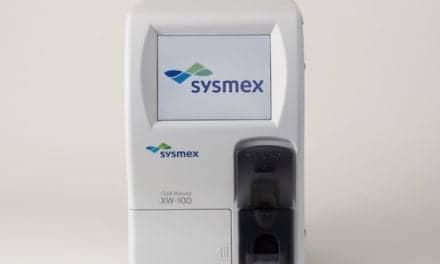How serology can aid in the diagnosis of this autoimmune disease during the pandemic.
By Veena Joy, MSc, and Dominic Andrada, MS
The COVID-19 pandemic continues to affect our all lives and livelihoods. In hospitals and other healthcare settings, limiting interactions that have the potential to transmit SARS-CoV-2 is important to protect the lives of patients, healthcare workers, and ancillary staff.
Although necessary, these safety precautions sometimes have significant implications on access to care. All across America, in-person appointments have been curtailed or delayed since the start of the pandemic, while some procedures, like the aerosol-generating endoscopy, have been taken off the table unless absolutely necessary.1 These changes have resulted in decreased access to important healthcare for patients who require essential but not immediately life-threatening procedures—which includes celiac disease (CD) diagnostics.
Historically, the cornerstone of CD diagnosis has been a duodenal biopsy with histological analysis, which is now considered a risky procedure due to the threat of SARS-CoV-2.1,2 With the reduction in elective procedures, many biopsies have been canceled or pushed back, often for 12 weeks or more.
So clinicians have had to choose between keeping their CD-suspected patients on gluten-containing diets until a biopsy can be scheduled or relying more heavily on other aspects of the recommended CD diagnostic criteria.
But there may be another option. Recent pediatric recommendations suggest that highly positive serology can function as a diagnostic indicator for celiac disease. As proposed by the 2012 and 2020 European Society for Pediatric Gastroenterology Hepatology and Nutrition (ESPGHAN) guidelines, autoimmune serology tests can support the confident diagnosis of CD. These tests are reliable and effective, and they offer a timely alternative to help relieve some of the anxiety of a pandemic-weary patient population.
Understanding CD and Gluten-Related Disorders
Gluten is the main structural protein of wheat, and despite this grain being a worldwide dietary staple, not all humans are able to completely digest this protein complex.3 Internal reactions or sensitivities to gluten are the main links between all gluten-related disorders, which affect approximately 5% of the world’s population.3 Gluten-related disorders include CD, wheat allergy, and nonceliac gluten sensitivity (NCGS). 4
CD, specifically, is an autoimmune disease in which a reaction to gluten consumption damages the small intestine. The global prevalence is steadily increasing, with a current prevalence of 1%.2 However, the true prevalence of CD is difficult to determine, since many cases remain either undiagnosed or misdiagnosed.
These missed diagnoses are in large part due to CD’s varying degrees of symptomology. CD manifests in two main forms—classic and silent or atypical. The symptoms found in the classic form are largely gastrointestinal and can mimic other conditions such as inflammatory bowel diseases (IBD). The silent or atypical form is more predominant in the adult population and encountered more frequently. This form typically lacks diarrhea and malabsorption symptoms, and some of these patients are truly asymptomatic.5 Asymptomatic, nondescript, and overlapping presentation of symptoms across all age groups makes diagnosis challenging and may lead to a prolonged time-to-diagnosis for CD of 4 to 12 years on average, with an estimated 83% of the CD population remaining undiagnosed.6,7
This lengthy wait comes with a human cost. All individuals with CD are at risk for long-term complications, whether they present with classic symptoms or none at all. Long-term complications can include malnutrition; bone fracture; infertility and miscarriage; autoimmune thyroid disease; cancer, especially intestinal lymphoma and small bowel cancers; cardiac disease, such as myocarditis and cardiomyopathy; and neuropsychiatric disease.8
Updated Guidelines
Duodenal histology is time-consuming, expensive, and invasive, and now the push to avoid procedures like these where possible has increased the incentive to find an alternative diagnostic approach that limits the reliance on biopsies in patients who fulfill other CD diagnostic criteria.
The updated guidelines ESPGHAN released in 2020 define four main components for the diagnosis of CD: celiac antibodies in serum; duodenal histology, which, historically, has been the determining factor; the presence of HLA-DQ2/DQ8 genes; and symptoms (which are no longer required for diagnosing children).9
Interestingly, the 2012 ESPGHAN guidelines allowed the option to omit duodenal histology in the presence of high serology titers, a recommendation based largely on retrospective data. With the latest 2020 guideline update, ESPGHAN reinforced this recommendation with the citation of more robust prospective studies.9
The Role of Serology in CD Diagnosis
The ESPGHAN guidelines from both 2012 and 2020 list the following serological markers for CD diagnosis:9,12
- Tissue transglutaminase-IgA (tTG IgA)
- Total IgA
- Endomysial antibodies (EMA IgA)
- IgG-based tests such as deamidated gliadin (DGP)
Increased disease awareness and serologic testing have improved CD diagnosis—in fact, they are thought to have filled in 10% to 20% of the diagnostic gap.6 Because CD has such a diverse presentation, not limited to a certain population, providers should have a low threshold for CD testing. Consequently, highly sensitive and specific tests are needed to support an accurate diagnosis.10
Now, in the midst of a pandemic that has limited access to one of the major diagnostic criteria for CD, clinicians need to place more importance on the serological testing. Awareness of the differences between assays—and ultimately differences in diagnostic accuracy—is now more important than ever. Understanding these nuances is critical to making an informed decision when choosing CD testing options for providers and patients. In addition, this increased focus on serologic testing allows laboratories to provide additional value to both providers and health systems.
The Importance of tTG-IgA
Between 1958 and 1978, three important markers were identified and combined to form a clinically useful approach to the diagnosis of CD: anti-gliadin (IgG and IgA-AGA), intestinal biopsy, and endomysial antibodies (IgA-EMA).10 These factors formed the algorithm of choice up until the identification of tissue transglutaminase (tTG) in 1997.10
tTG is a key enzyme in a cascade of destruction that leads to the deamidation of gliadin and disease manifestation defined in CD.11 Because of this, tTG is a crucial marker in the diagnosis of CD—the 2020 ESPGHAN guidelines list it as the most accurate and cost-effective initial screening test for CD.9
Multiple tTG-IgA tests are commercially available today, with varying degrees of sensitivity and specificity. Four more common North American tTG-IgA assays are listed within Table 1.
| tTG-IgA assay | Sensitivity(%) | Specificity(%) |
| Thermo Fisher Scientific EliA Celikey tTG-IgA | 90.7 | 100 |
| Inova DiagnosticsQuanta Lite h-tTG IgA | 87.9 | 98.8 |
| Euroimmun AGAnti-tissue transglutaminase ELISA (IgA) | 97.9 | 97.9 |
| AeskuAeskulisa tTG-A New Generation | 76.4 | 98.8 |
Table 1: Sensitivity and Specificity of 4 Commonly Used tTG-IgA Assays in North American Populations; 140 CD, 86 controls 12
Since CD is such a low-prevalence disease state, serology tests with high specificity are necessary for diagnostic accuracy and increased confidence in diagnosis without a biopsy.
The 2012 and 2020 ESPGHAN guidelines suggest that a diagnosis of CD can be made without a biopsy if a patient’s tTG-IgA levels are 10 times the upper limit of normal and a second serum sample has a positive anti-endomysial antibody (EMA) test.9,13 Several studies have demonstrated the effectiveness of this serology-centric approach. One applied the 2012 ESPGHAN guidelines in a cohort of prospective pediatric patients. In that study, tTG-IgA was tested among eight different platforms to determine the level of tTG-IgA that is needed to provide 99% positive predictive value (PPV).14
All tests reached 99% PPV at 10 times the upper limit of normal (ULN), with a few select tests reaching 99% PPV at just two to four times the ULN.14 Achieving a 99% PPV at such a low ULN suggests that more children can be identified for CD without the potential risk and cost of biopsy.
Serology-Based Diagnosis in Practice
Europe is currently leading the way with serology-based CD diagnosis. There, they have found that tTG-IgA testing has the potential to reduce the need for gastroscopy with biopsy by 30% to 50%.2,9 Now, during the covid-19 pandemic with limitations being placed on endoscopies, the rest of the world is having to adapt and follow suit.
tTG-IgA is the first-line screening test being recommended across all populations.2 Therefore, it is crucial to have confidence in the assay being used. Selecting the most reliable assay, by understanding the nuances in assay variation and its subsequent effect on diagnostic accuracy, enables the laboratory to play a critical role in the management of patients with suspected celiac disease.
Veena Joy, MSc, is clinical affairs manager, autoimmunity, for Thermo Fisher Scientific.
Dominic Andrada, MS, is marketing manager, autoimmunity, for Thermo Fisher Scientific.
References
1. Repici A, Maselli R, Columbo M, et al. Coronavirus (COVID-19) outbreak: what the department of endoscopy should know. Gastroinest Endosc. 2020;92(1):192-197. doi: 10.1016/j.gie.2020.03.019.
2. Husby S, Murray JA, Katzka DA. Clinical practice update on diagnosis and monitoring of celiac disease: changing utility of serology and histologic measures: expert review. Gastroenterology. 2019;156(4):885-889. doi: 10.1053/j.gastro.2018.12.010.
3. Elli L, Branchi F, Tomba C, et al. Diagnosis of gluten related disorders: celiac disease, wheat allergy and non-celiac gluten sensitivity. World J Gastroenterol. 2015;21(23):7110-7119. doi: 10.3748/wjg.v21.i23.7110.
4. Sapone A, Bai JC, Ciacci C, et al. Spectrum of gluten-related disorders: consensus on new nomenclature and classification. BMC Med. 2012;10:13. doi: 10.1186/1741-7015-10-13.
5. Rampertab SD, Pooran N, Brar P, Singh P, Green PHR. Trends in the presentation of celiac disease. Am J Med. 2006;119(4):355.e9-355.e3.55E14. doi: 10.1016/j.amjmed.2005.08.044.
6. Cichewicz A, Mearns ES, Taylor A, et al. Diagnosis and treatment patterns in celiac disease. Dig Dis Sci.2019;64(8):2095-2106. doi: 10.1007/s10620-019-05528-3.
7. Rubio-Tapia A, Ludvigsson JF, Brantner TL, Murray JA, Everhart JE. The prevalence of celiac disease in the United States. Am J Gastroenterol. 2012;107(10):1538-1544; doi: 10.1038/ajg.2012.219.
8. Haines ML, Anderson RP, Gibson PR. Systematic review: the evidence base for long-term management of coeliac disease. Aliment Pharmacol Ther. 2008;28(9):1042-1066. doi: 10.1111/j.1365- 2036.2008.03820.x.
9. Husby S, Koletzko S, Korponary-Szabo IR, et al. European Society Paediatric Gastroenterology, Hepatology and Nutrition Guidelines for Diagnosing Coeliac Disease 2020. J Pediatr Gastroenterol Nutr. 2020;70(1):141-156. doi: 10.1097/MPG.0000000000002497.
10. Bürgin-Wolff A, Dahlbom I, Hadziselimovic F, Petersson CJ. Antibodies against human tissue transglutaminase and endomysium in diagnosing and monitoring coeliac disease. Scand J Gastroenterol. 2002;37(6):685-691. doi: 10.1080/00365520212496.
11. Szondy Z, Korponary-Szabo IR, Kiraly R, Sarang Z, Tsay GJ. Transglutaminase 2 in human diseases. Biomedicine (Taipei). 2017;7(3):15. doi: 10.1051/bmdcn/2017070315.
12. Singh P, Singh A, Silvester JA, Sachdeva V, Chen X, Xu H, Leffler DA, Ahuja V, Duerksen DR, Kelly CP, Makharia GK. Inter- and Intra-assay Variation in the Diagnostic Performance of Assays for Anti-tissue Transglutaminase in 2 Populations. Clin Gastroenterol Hepatol. 2020 Oct;18(11):2628-2630. doi: 10.1016/j.cgh.2019.09.018. Epub 2019 Sep 20. PMID: 31546060; PMCID: PMC7082178.
13. Husby S, Koletzko S, Korponary-Szabo I, et al. European Society for Pediatric Gastroenterology, Hepatology, and Nutrition Guidelines for the Diagnosis of Coeliac Disease. J Pediatr Gastroenterol Nutr. 2012;54(1):136-60. doi: 10.1097/MPG.0b013e31821a23d0.
14. Werkstetter KJ, Korponary-Szabo IR, Popp A, et al. Accuracy in diagnosis of celiac disease without biopsies in clinical practice. Gastroenterology. 2017;153:924–935. doi: 10.1053/j.gastro.2017.06.002.





